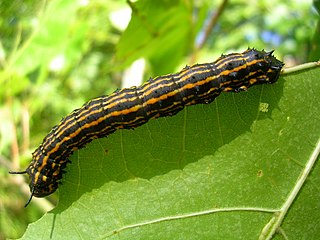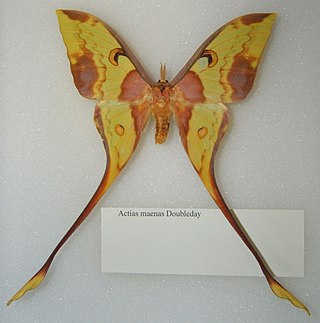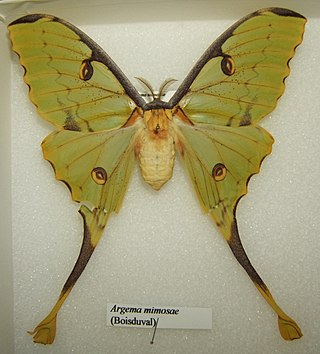
Moths are a group of insects that includes all members of the order Lepidoptera that are not butterflies. They were previously classified as suborder Heterocera, but the group is paraphyletic with respect to butterflies and neither subordinate taxon is used in modern classifications. Moths make up the vast majority of the order. There are approximately 160,000 species of moth, many of which have yet to be described. Most species of moth are nocturnal, although there are also crepuscular and diurnal species.

The luna moth, also called the American moon moth, is a Nearctic moth in the family Saturniidae, subfamily Saturniinae, a group commonly named the giant silk moths.

Saturniidae, members of which are commonly named the saturniids, is a family of Lepidoptera with an estimated 2,300 described species. The family contains some of the largest species of moths in the world. Notable members include the emperor moths, royal moths, and giant silk moths.

Eacles imperialis, the imperial moth, is a member of the family Saturniidae and subfamily Ceratocampinae. It is found mainly in the East of South America and North America, from the center of Argentina to south Canada. The species was first described by Dru Drury in 1773.

Antheraea polyphemus, the Polyphemus moth, is a North American member of the family Saturniidae, the giant silk moths. It is a tan-colored moth, with an average wingspan of 15 cm (6 in). The most notable feature of the moth is its large, purplish eyespots on its two hindwings. The eyespots give it its name – from the Greek myth of the cyclops Polyphemus. The species was first described by Pieter Cramer in 1776. The species is widespread in continental North America, with local populations found throughout subarctic Canada and the United States. The caterpillar can eat 86,000 times its weight at emergence in a little less than two months. Polyphemus moths are considered to be very polyphagous, meaning they eat from a wide variety of plants.

Dryocampa rubicunda, the rosy maple moth, is a small North American moth in the family Saturniidae, also known as the great silk moths. It was first described by Johan Christian Fabricius in 1793. The species is known for its wooly body and pink and yellow coloration, which varies from cream or white to bright pink or yellow. Males have bushier antennae than females, which allow them to sense female pheromones for mating.

Anisota senatoria, the orangestriped oakworm, also known as the orange-tipped oakworm, is a Nearctic moth of the family Saturniidae and subfamily Ceratocampinae. It is one of the more common Saturniids, reaching pest status occasionally in the northern parts of its range. As they are late-season feeders, however, they do little lasting damage to their hosts. It is very similar to A. finlaysoni in southern Ontario and A. peigleri in the southern US. The species was first described by James Edward Smith in 1797.

The dryandra moth is a species of moth that is considered to be the sole member of the family Carthaeidae. Its closest relatives are the Saturniidae and it bears a resemblance to many species of that family, bearing prominent eyespots on all wings. The common name is derived from the Dryandra shrubs of the genus Banksia, on which the larva of this species feed, and is hence restricted to the south-west of Western Australia where these shrubs grow. Other Grevillea shrubs may also be used as host plants.

The Malaysian moon moth is a Saturniid in the subfamily Saturniinae from Indomalaya. The male is purplish-brown and yellow, while the larger female is overall light green.

The Sulawesi moon moth or Isis moon moth is a moth of the family Saturniidae first described by Léon Sonthonnax in 1899.

Argema mimosae, the African moon moth, is a giant silk moth of the family Saturniidae. Similar in appearance to the giant Madagascan moon moth, but smaller, this moth can be found widely in Eastern Africa and more locally in Southern Africa, including near the east coast of South Africa. The species was first described by Jean Baptiste Boisduval in 1847. An adult can measure 10 to 12 centimetres across its wingspan and 12 to 14 centimetres from head to the tip of its elongated tail-like second pair of wings. Its forward wings have a distinctive grey-coloured "furry" leading edge, giving a very rough surface, presumably for aerodynamic reasons. Apart from the eye-like markings on its wings, the colouring and shape of the wings give the appearance of a piece of foliage, especially the tail-like structures of the rearmost wings which resemble a dried out leaf stem - presumably for camouflage in its natural environment.

Coscinocera hercules, the Hercules moth, is a moth of the family Saturniidae, endemic to New Guinea and northern Australia. The species was first described by William Henry Miskin in 1876.

Arsenura armida, the giant silk moth, is a moth of the family Saturniidae. It is found mainly in South and Central America, from Mexico to Bolivia, and Ecuador to south-eastern Brazil. It was first described by Pieter Cramer in 1779.
Eochroa is a monotypic moth genus in the family Saturniidae erected by Felder in 1874. Its only species, Eochroa trimenii, was also described by Felder in the same year. They inhabit arid rocky areas and mountain passes in Africa where the host plant grows.

Anisota virginiensis, the pink-striped oakworm moth, is a species of silk moth of the family Saturniidae.

Hylesia nigricans is a species of Lepidoptera of the family Saturniidae. It is a nocturnal moth endemic to Argentina and Brazil. It can be found mainly in the north and center of Argentina, the south of Bolivia and the south of Brazil, due to climatic factors which favor its reproduction. The species was first described by Carlos Berg in 1875.

Citheronia laocoon is a species of moth in the family Saturniidae. It is found from the Guianas south to northern Argentina.

Antheraea paphia, known as the South India small tussore, the tasar silkworm and vanya silkworm is a species of moth of the family Saturniidae found in India and Sri Lanka. The bulk of the literature on this species uses a junior synonym, Antheraea mylitta, rather than the correct name, A. paphia. It is one of a number of tasar silkworms, species that produce Tussar silk, a kind of wild silk that is made from the products of saturniid silkworms instead of the domesticated silkworm.
Zebronia phenice is a moth in the family Crambidae. It was described by Stoll in 1782. It is found in Cameroon, Mayotte, the Democratic Republic of Congo, Equatorial Guinea, Ethiopia, Gabon, Ghana, Ivory Coast, Kenya, La Réunion, Madagascar, Mauritius, Mozambique, Nigeria, Senegal, Sierra Leone, South Africa, Tanzania, Gambia, Uganda, Zambia and Zimbabwe.

Hemileuca nuttalli, or Nuttall's sheep moth, is a moth in the family Saturniidae. It is found from south-eastern British Columbia to eastern Washington, eastern Oregon, north-eastern California, Idaho, Nevada, northern Arizona, Utah, Montana, Wyoming, Colorado and north-western New Mexico. The species was first described by Ferdinand Heinrich Hermann Strecker in 1875 under the name Pseudohazis nuttalli.



















